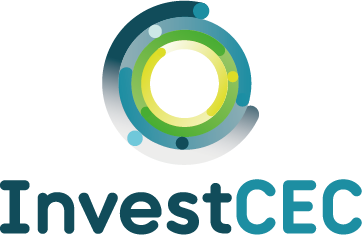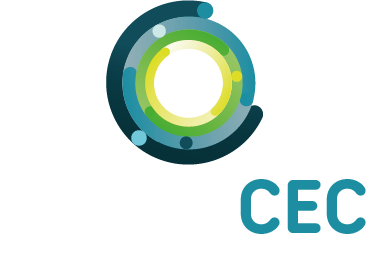We had the pleasure to have a chat with Kathrina Rieger (Austria Regional Manager) and Dominik Campanella (Chief Executive Officer and Co-founder) from Concular GmbH, one of the most innovative companies leading the circular transition in the construction sector.
Concular provides a digital ecosystem for circular construction, delivering products and services such as circular consulting, building resource passports and life cycle assessments (LCAs) through their software CircularLCA, and the digital marketplace for reused building materials. Their business model combines SaaS licensing, consulting services, and material brokerage to help clients plan, document, and implement circular, low-carbon construction projects.
Building up on the collaboration during the InvestCEC call for entrepreneurs, Kathrina Rieger joined the InvestCEC final event at the European Parliament on October 14th, where she gave her perspective in the panel “Driving the Circular Transition trough public procurement and strategic partnerships”.
We spoke with Kathrina and Dominik regarding their vision, their challenges and opportunities in attracting investments, their strategy, and goals for the future to shape a more sustainable built environment.
What does it mean to be a circular economy entrepreneur? Do you identify as such?
Yes, absolutely. Being a circular economy entrepreneur means fundamentally rethinking how we design, build, and value our material world. It’s not only about recycling — it’s about preserving the value of materials, components and buildings through reuse, repair, and smart design.
At Concular, we see buildings as temporary material banks. We use digital tools and standards like the DIN SPEC 91484 (Pre-Deconstruction-Audits), which Concular initiated, to document and manage materials so they can re-enter the market after deconstruction. So yes — I fully identify as a circular entrepreneur, because our mission is to turn the construction industry from a linear, wasteful system into a regenerative, data-driven one.
As an entrepreneur in this space, what were some of the key challenges you faced when attracting investments, particularly given the circular nature of your business?
One of the biggest challenges was that investors often look for fast-scaling, asset-light business models — whereas circular models require patience, infrastructure, and collaboration across sectors.
We had to educate investors that circularity isn’t a niche sustainability project —it’s a trillion-euro transformation opportunity. Also, the value we create — such as CO₂ savings, avoided waste, and regulatory readiness — isn’t always captured in traditional financial metrics. We had to show that circular business models are not just environmentally sound, but economically resilient in a world of material scarcity and tightening climate regulation.
What strategies and partnerships do you think are crucial for positioning the circular economy as the dominant business model of the future?
The key is collaboration between data, policy, and practice:
- On the digital side, we need open, interoperable data standards for material passports and life cycle information
- On the regulatory side, governments must set Whole-Life-Carbon (WLC) limits and reuse targets, making circularity the default rather than the exception.
- On the industrial side, partnerships with demolition firms, developers, and manufacturers are essential to build Urban Mining Hubs — physical spaces where reuse becomes tangible.
At Concular, we combine all three: we provide the digital ecosystem, invest in reuse logistics infrastructure, and help shape policy frameworks at both national and EU level.
Have you worked with the public sector before, or do you see collaboration with governments as part of your future strategy?
Yes, we actively collaborate with the public sector.
Concular is currently working with federal and regional governments across Germany, including the State of North Rhine-Westphalia, which just signed a cooperation agreement with us to integrate the building resource passport into public funding programs.
We also work closely with the German Sustainable Building Council (DGNB), the European Commission’s Leadership Group for Circular Construction, and various cities like Berlin and Stuttgart.
Public-private partnerships are essential — because the public sector owns a large share of Europe’s building stock and can set the pace for transformation.
Why is now the right time for Concular?
Because the construction sector accounts for 40 % of CO₂ emissions and 60 % of all waste — and we’ve reached a point where climate neutrality is impossible without circular construction.
At the same time, new regulations like the EU Construction Products Regulation, the Circular Economy Act, and national Whole-Life-Carbon limits are making circularity a legal and economic necessity.
Concular provides the digital and physical infrastructure to implement this transformation — right when the market, policy, and public awareness align. In short: the timing couldn’t be better — the circular economy is shifting from vision to obligation, and we’re providing the tools to make it real.
How did you benefit from participating in InvestCEC?
Participating in InvestCEC has been highly beneficial for us in several ways. First, it enabled us to connect with the City of Klagenfurt and establish an initial touchpoint to briefly explore how our solutions could support their goals.
Second, advancing to the next round provided us with a strong proof of concept, which strengthens our credibility when engaging with future clients and stakeholders. Additionally, being invited to the European Parliament was a great honor and further highlights both our commitment to the topic and the relevance of our approach.
Finally, it was extremely valuable to see our practical experiences reflected in theoretical models — particularly regarding how the growth of circular business models can be constrained by other actors within the ecosystem. This helped us to better articulate and address a challenge we have been facing for some time.
Looking ahead, what are the next steps for your business? What are some of your immediate goals, and where do you see your company in the next 5 to 10 years?
Looking ahead, our next steps focus on further scaling our solutions and expanding collaborations with a growing number of market players. Our goal is to deploy scalable approaches that keep products and materials in circulation for as long as possible.
In the next five years, we envision a market where established systems for reuse and recycling exist across all major product groups in the construction sector. We aim to contribute significantly to making such circular pathways standard practice.
Over the next 10 years, we see our company playing a key role in driving a mindset shift: when starting a building project, people will automatically turn to secondary materials first. With open-source data platforms that match supply and demand efficiently, we want to provide the foundation for circular, low-emission buildings — making circular construction not only environmentally responsible, but also easy, accessible, and economically viable for everyone.
This interview was curated by Giorgio Alessandro (Greenovate! Europe) for the InvestCEC project and it is based on responses by Kathrina Rieger (Concular) and Dominik Campanella (Concular).

